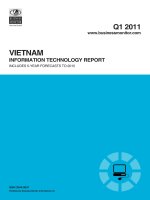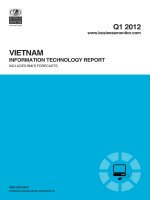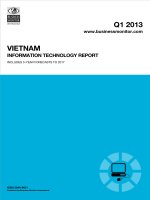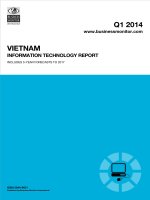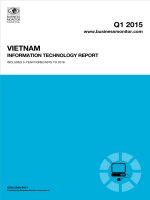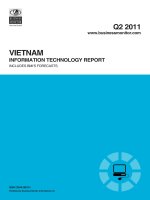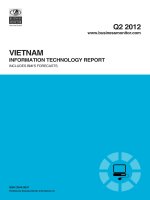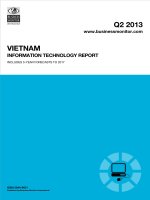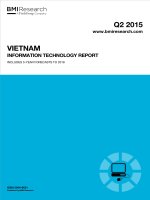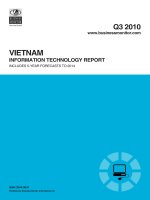Vietnam information technology report q3 2012
Bạn đang xem bản rút gọn của tài liệu. Xem và tải ngay bản đầy đủ của tài liệu tại đây (515.14 KB, 64 trang )
Q3 2012
Published by Business Monitor International Ltd.
www.businessmonitor.com
INFORMATION TECHNOLOGY REPORT
ISSN 2044-9631
Published by Business Monitor International Ltd.
VIETNAM
INCLUDES BMI'S FORECASTS
Business Monitor International
85 Queen Victoria Street
London
EC4V 4AB
UK
Tel: +44 (0) 20 7248 0468
Fax: +44 (0) 20 7248 0467
Email:
Web:
© 2012 Business Monitor International.
All rights reserved.
All information contained in this publication is
copyrighted in the name of Business Monitor
International, and as such no part of this publication
may be reproduced, repackaged, redistributed, resold in
whole or in any part, or used in any form or by any
means graphic, electronic or mechanical, including
photocopying, recording, taping, or by information
storage or retrieval, or by any other means, without the
express written consent of the publisher.
DISCLAIMER
All information contained in this publication has been researched and compiled from sources believed to be accurate and reliable at the time of
publishing. However, in view of the natural scope for human and/or mechanical error, either at source or during production, Business Monitor
International accepts no liability whatsoever for any loss or damage resulting from errors, inaccuracies or omissions affecting any part of the
publication. All information is provided without warranty, and Business Monitor International makes no representation of warranty of any kind as
to the accuracy or completeness of any information hereto contained.
VIETNAM INFORMATION
TECHNOLOGY REPORT
Q3 2012
INCLUDES 5-YEAR FORECASTS TO 2016
Part of BMI’s Industry Report & Forecasts Series
Published by: Business Monitor International
Copy deadline: August 2012
Vietnam Information Technology Report Q3 2012
© Business Monitor International Ltd Page 2
Vietnam Information Technology Report Q3 2012
© Business Monitor International Ltd Page 3
CONTENTS
Executive Summary 5
SWOT Analysis 7
Vietnam IT Sector SWOT 7
Vietnam Telecom SWOT 8
Vietnam Political SWOT 9
Vietnam Economic SWOT 10
Vietnam Business Environment SWOT 11
Asia Pacific IT Risk/Reward Ratings 12
Table: Asiapacific It Risk/Reward Ratings 17
IT Markets Overview 18
Market Overview 26
Government Authority 26
Industry Developments 35
Industry Forecast 39
Table: Vietnam IT Industry – Historical Data And Forecasts (US$mn unless otherwise stated), 2008-2016 42
Industry Forecast Internet 43
Table: Telecoms Sector – Internet – Historical Data And Forecasts, 2009-2016 43
Competitive Landscape 45
Hardware 45
Software 47
Operating Systems 48
IT Services 51
Macroeconomic Forecast 53
Table: Vietnam – Economic Activity, 2011-2016 55
Company Profiles 56
FPT Software 56
Demographic Outlook 57
Table: Vietnam's Population By Age Group, 1990-2020 ('000) 58
Table: Vietnam's Population By Age Group, 1990-2020 (% of total) 59
Table: Vietnam's Key Population Ratios, 1990-2020 60
Table: Vietnam's Rural And Urban Population, 1990-2020 60
BMI Methodology 61
How We Generate Our Industry Forecasts 61
Transport Industry 61
Sources 62
Vietnam Information Technology Report Q3 2012
© Business Monitor International Ltd Page 4
Vietnam Information Technology Report Q3 2012
© Business Monitor International Ltd Page 5
Executive Summary
BMI View: Vietnamese IT spending is expected to reach US$2.6bn in 2012, up 14%, with BMI upwardly
revising its forecast due to macroeconomic factors. Drivers such as rising PC penetration, economic
growth, a range of government ICT initiatives and a campaign to develop Vietnam's domestic IT industry
will help to sustain continued expansion going forward. Vietnam's improving ICT infrastructure will also
drive the development of the nation's IT market in a country with below 20% PC penetration. Meanwhile,
cloud computing revenues are expected to report at least 300% growth over the forecast period.
Headline Expenditure Projections
Computer hardware sales: US$1.60bn in 2011 to US$1.85bn in 2012, +12% in US dollar terms.
Forecast in US dollar terms unchanged, but due to lower prices tablets are expected to provide a strong
growth area in 2012.
Software sales: US$191mn in 2011 to US$224mn in 2012, +17% in US dollar terms. Forecast in US
dollar terms upwardly revised due to analyst modification, but will depend on the success in bringing
down illegal software use.
IT Services sales: US$402mn in 2011 to US$478mn in 2012, +19% in US dollar terms. Forecast in US
dollar terms upwardly revised due to analyst modification with growing demand for digital
infrastructure projects in various sectors, such as banking, telecoms, energy and government.
Risk/Reward Ratings: Vietnam's score was 33.2 out of 100.0. Vietnam ranks 11th in our latest Asia
RRR table, ahead of Sri Lanka. The country ranked only ninth for its IT market score of 36.
Key Trends & Developments.
The Vietnam IT market is expected to grow around 14% in 2012. Government and business IT
spending remain subject to fiscal restraints and external economic headwinds, and the
devaluation of the dong will also inhibit demand. However, the Vietnamese economy is expected
to remain generally strong and drive growth in IT investments.
In 2011, a number of government ministries and organisations, including the Ministry of
Education and Training, started to promote the roll out of cloud services. Plans to modernise IT
in government agencies and the customs department, as well as the Tax Administration
Modernization Plan for 2008-2013 represent opportunities for vendors of IT products and
services.
Vietnam Information Technology Report Q3 2012
© Business Monitor International Ltd Page 6
An ambitious government IT plan for 2010-2020 should shape many segments of the
Vietnamese IT market, with the government pledging to invest VND2.4tn (US4,115mn) from
the State Budget in the ICT sector over the next decade. The government's increasing focus on
encouraging ICT development and foreign investment in the tech sector will also create
opportunities. Many of the government's ICT development plans and programmes are still in a
nascent stage and their ultimate effectiveness is yet to be determined.
Vietnam Information Technology Report Q3 2012
© Business Monitor International Ltd Page 7
SWOT Analysis
Vietnam IT Sector SWOT
Strengths
The domestic IT market is in a rapid growth phase, with trade liberalisation and
growing affordability driving projected double-digit growth of notebook
computers.
Expanding ICT infrastructure and internet penetration will continue to drive
demand for IT products and services.
Vietnam's gradual integration into the global trade network via its accession into
trade organisations such as ASEAN and WTO, as well as bilateral agreements
with Japan and China.
Weaknesses
IT spend per capita much lower than in neighbouring Thailand, reflecting a
much lower GDP and GDP per capita.
Low levels of access to credit and budgets restrain spending by SMEs.
Highly cost-sensitive market, with 75% of software provided by lower-cost local
software vendors.
High level of software piracy at 85%, although it has fallen in the last few years.
Opportunities
High PC market growth potential particular in rural areas due to overall low PC
penetration rate of 15%.
Vast and relatively under-penetrated rural market presents a significant growth
opportunity as the government rolls out measures to boost rural connectivity
and incomes.
National IT Plan will drive spending on IT utilisation in areas like e-government,
e-taxation and education.
SMEs have much potential to increase spending on basic solutions, including
customer relationship management and security.
One Teacher-One Computer programme aims to deliver 1mn computers to
schools by 2011.
The banking and finance sector is a promising area for database software and
one where foreign companies have done well.
Banking and finance, oil and gas, aviation and telecoms are projected to be
some of the biggest opportunities for multinational vendors.
Tax agencies at all levels of administration are looking to increase the efficiency
of tax collection.
The government's drive to create a significant IT services industry over the next
15-20 years is expected to be a significant factor shaping the IT market.
Threats
Continued depreciation of the dong against the US dollar would increase the
pressure on Vietnamese distributors of foreign IT goods.
Falling prices may further undermine margins and profitability after steep
discounting in 2009.
The implementation of the China-ASEAN free trade agreement means that
established multinationals will face a growing challenge from low-cost Chinese
vendors in the Vietnamese market.
Vietnam Information Technology Report Q3 2012
© Business Monitor International Ltd Page 8
Vietnam Telecom SWOT
Strengths
Fixed-line penetration levels and internet user rates are high in major urban
centres, such as Ho Chi Minh City, Hanoi, Danang and Haiphong.
Competition exists in fixed-line and internet access markets; VNPT faces
competition from several other state-owned companies and two privately-owned
operators.
High levels of literacy and other demographic factors bode well for strong and
continued demand for wireline services over the next few years.
Weaknesses
Vietnam's fixed-line and internet access markets are both dominated by state-
controlled operators, VNPT and Viettel.
Although alternative broadband infrastructures are currently being explored,
broadband growth continues to be dependent on DSL.
Low fixed-line penetration rates in rural regions limit the scope for DSL
broadband growth.
Internet user growth is slowing, despite the limited access to internet
infrastructure in much of rural Vietnam.
Broadband tariffs remain high, creating a barrier for low-income subscribers to
access.
Opportunities
The privatisation of VNPT could help to bring about increased investment
revenues and the arrival of new skills.
On a national level, broadband penetration rates remain low; this means that
the sector has considerable growth potential.
VNPT plans to invest US$1bn in 2009, in order to upgrade its broadband
networks and expand its international internet bandwidth.
Significant opportunities exist to develop alternative broadband technologies,
including WiMAX and fibre.
WiMAX services are currently being trialled with a view to licensing a number of
WiMAX service providers in the near future; WiMAX internet services have the
potential to raise the level of internet user penetration in rural parts of Vietnam.
Draft Bill of Law on Telecommunication has been put forward for discussion at
the National Assembly Steering Committee. If passed, the bill will allow private
companies to build network infrastructure for the first time and will open up the
telecoms market to foreign investors.
Threats
Fixed-line sector may enter a period of decline, with potentially negative
consequences for ADSL growth.
As the market for mobile data services grows, this could have potentially
negative consequences for the growth of fixed broadband services.
Vietnam Information Technology Report Q3 2012
© Business Monitor International Ltd Page 9
Vietnam Political SWOT
Strengths
The Communist Party of Vietnam remains committed to market-oriented
reforms and we do not expect major shifts in policy direction over the next five
years. The one-party system is generally conducive to short-term political
stability.
Relations with the US have witnessed a marked improvement, and Washington
sees Hanoi as a potential geopolitical ally in South East Asia.
Weaknesses
Corruption among government officials poses a major threat to the legitimacy of
the ruling Communist Party.
There is increasing (albeit still limited) public dissatisfaction with the leadership's
tight control over political dissent.
Opportunities
The government recognises the threat corruption poses to its legitimacy, and
has acted to clamp down on graft among party officials.
Vietnam has allowed legislators to become more vocal in criticising government
policies. This is opening up opportunities for more checks and balances within
the one-party system.
Threats
Macroeconomic instabilities in 2012 are likely to weigh on public acceptance of
the one-party system, and street demonstrations to protest economic conditions
could develop into a full-on challenge of undemocratic rule.
Although strong domestic control will ensure little change to Vietnam's political
scene in the next few years, over the longer term, the one-party state will
probably be unsustainable.
Relations with China have deteriorated over recent years due to Beijing's more
assertive stance over disputed islands in the South China Sea and domestic
criticism of a large Chinese investment into a bauxite mining project in the
central highlands, which could potentially cause wide-scale environmental
damage.
Vietnam Information Technology Report Q3 2012
© Business Monitor International Ltd Page 10
Vietnam Economic SWOT
Strengths
Vietnam has been one of the fastest-growing economies in Asia in recent years,
with GDP growth averaging 7.1% annually between 2000 and 2011.
The economic boom has lifted many Vietnamese out of poverty, with the official
poverty rate in the country falling from 58% in 1993 to 14.0% in 2010.
Weaknesses
Vietnam still suffers from substantial trade, current account and fiscal deficits,
leaving the economy vulnerable to global economic uncertainties in 2012. The
fiscal deficit is dominated by substantial spending on social subsidies that could
be difficult to withdraw.
The heavily managed and weak currency reduces incentives to improve quality
of exports, and also keeps import costs high, contributing to inflationary
pressures.
Opportunities
WTO membership has given Vietnam access to both foreign markets and
capital, while making Vietnamese enterprises stronger through increased
competition.
The government will, in spite of the current macroeconomic woes, continue to
move forward with market reforms, including privatisation of state-owned
enterprises, and liberalising the banking sector.
Urbanisation will continue to be a long-term growth driver. The UN forecasts the
urban population rising from 29% of the population to more than 50% by the
early 2040s.
Threats
Inflation and deficit concerns have caused some investors to re-assess their
hitherto upbeat view of Vietnam. If the government focuses too much on
stimulating growth and fails to root out inflationary pressure, it risks prolonging
macroeconomic instability, which could lead to a potential crisis.
Prolonged macroeconomic instability could prompt the authorities to put reforms
on hold as they struggle to stabilise the economy.
Vietnam Information Technology Report Q3 2012
© Business Monitor International Ltd Page 11
Vietnam Business Environment SWOT
Strengths
Vietnam has a large, skilled and low-cost workforce, that has made the country
attractive to foreign investors.
Vietnam's location – its proximity to China and South East Asia, and its good
sea links – makes it a good base for foreign companies to export to the rest of
Asia, and beyond.
Weaknesses
Vietnam's infrastructure is still weak. Roads, railways and ports are inadequate
to cope with the country's economic growth and links with the outside world.
Vietnam remains one of the world's most corrupt countries. According to
Transparency International's 2011 Corruption Perceptions Index, Vietnam ranks
112 out of 183 countries.
Opportunities
Vietnam is increasingly attracting investment from key Asian economies, such
as Japan, South Korea and Taiwan. This offers the possibility of the transfer of
high-tech skills and know-how.
Vietnam is pressing ahead with the privatisation of state-owned enterprises and
the liberalisation of the banking sector. This should offer foreign investors new
entry points.
Threats
Ongoing trade disputes with the US, and the general threat of American
protectionism, which will remain a concern.
Labour unrest remains a lingering threat. A failure by the authorities to boost
skills levels could leave Vietnam a second-rate economy for an indefinite period.
Vietnam Information Technology Report Q3 2012
© Business Monitor International Ltd Page 12
Asia Pacific IT Risk/Reward Ratings
BMI's Asia Pacific IT Risk/Reward Ratings (RRR) compares the potential of a selection of the region's
markets over our forecast period through to 2016. Our Q312 ratings reflect our consideration of the
political and economic risks, as well as the risks associated specifically with IT intellectual property (IP)
rights protection and the implementation of state spending projects.
While there were changes to the countries' individual scores, the rankings were largely unaffected. The
only change came in the form of Indonesia overtaking India and Thailand to become the eighth ranked
country among the 12 covered in the Asia Pacific region by BMI.
Singapore retained its leader position with an IT Ratings score of 74.1. Although Singapore's IT market is
significantly smaller than many of its regional peers, the country has other redeeming factors. For
example, Singapore is highly urbanised with a pool of skilled labour. The country is also strategically
placed at the heart of South East Asia amid emerging markets such as Indonesia and Thailand. Its strong
infrastructure (which includes access to major submarine cable networks and high-speed broadband
connectivity), political stability and pro-business environment attract foreign investors and spur
technological developments.
Singapore's ambitions to emerge as a regional cloud computing hub will fuel vendor investment in service
capabilities. In February 2011, the Infocomm Development Authority of Singapore and the Information
Technology Standards Committee (ITSC) formed a Cloud Computing Standards Coordinating Task Force
to: 'address the industry demands for cloud computing standards and coordinate the cloud computing
standardisation efforts across the different Technical Committees in ITSC'.
Australia closed the gap with Singapore by achieving an IT Ratings score of 73.2, up from 70.9 in the
previous quarter. The upgrade was largely due to an improvement in its IT Market score, although an
increase in its Country Risk score aided as well. Due to the country's sheer size, it is inevitable that
certain regions suffer from a deficiency in IT network and services. However, the government has been
looking to resolve the issue with its ambitious National Broadband Network (NBN), which aims to
deliver nationwide high-speed broadband connectivity with a combination of fibre, fixed-wireless and
satellite technologies. The introduction of high-speed broadband connectivity should fuel demand for
sophisticated services such as cloud computing (which is already being embraced by the public sector and
enterprises), machine-to-machine (M2M) connectivity and telepresence as well as devices, as the industry
moves towards ubiquitous connectivity and internet-connected homes.
Hong Kong saw its IT Ratings score rise to 72.6 from 69.4 in the previous quarter. Like Australia, the
improvement was fuelled by an upgrade in its IT Market score, although the positive effect was partially
Vietnam Information Technology Report Q3 2012
© Business Monitor International Ltd Page 13
offset by a decline in the territory's Country Risk score. Hong Kong has one of the lowest fibre broadband
tariff rates in the world, and this provides the backbone for next generation IT services such as cloud
computing and data centres. Hong Kong is also well connected to the international submarine cable
network, and the territory is one of the 11 landing sites for the new 10,400km Asia Pacific Gateway
(APG) system. The network, which is scheduled to become operational by June 2014, is designed for an
initial transmission speed of 40Gbps per wavelength, using Digital Coherent detection and Optical Add-
Drop Multiplexing technologies, according to Japan's NEC. The APG system will be able to
accommodate 100Gbps for increasing efficiency and capacity in the future.
Similar to its developed peers in the region, South Korea is also encouraging the utilisation of cloud
computing by small businesses. New cloud computing offerings and increased competition in this
segment are expected to fuel growing demand to use this technology. Other areas of growth include M2M
and telecare, which are led by technological advancements in the underlying networks. At the end of
January 2012, there were 44mn 3G subscribers and 2.8mn 4G (comprising WiBro and LTE) users. By
comparison, there were only 6.7mn 2G subscribers.
However, besides being vulnerable to the global headwind, South Korea's economy has its own
problems. Firstly, South Korea's household debt situation remains an overriding concern. While a
collapse in the housing debt market looks to be an unlikely scenario, considerable risk remains from
households' debt servicing capacities as the economy heads south. Secondly, its external debt situation
puts the economy in a very precarious position. Given that a significant portion of external debt is held by
foreign bank branches and is short-term in nature, a sudden bout of risk aversion could see substantial
foreign capital outflows.
Malaysia remained in fifth position in our Q312 regional ratings. There are increasingly attractive
opportunities in the IT services area as the government implements measures to make Malaysia a growing
regional services and outsourcing hub. Guiding the government and industry is the country's Economic
Transformation Programme, which has earmarked areas such as cloud computing as one of its top 10
strategic technology priorities. The rollout of the High Speed Broadband network will also boost IT
spending outside the Klang Valley and help the country achieve a household broadband penetration rate
of 75% by 2015. Other projected growth and PC market drivers include a rise in the PC penetration level
from about 35%, tax exemptions for notebooks and growth in disposable incomes.
Our Chinese hard landing view is playing out well, evidenced by the People's Bank of China's decision to
cut its reserve requirement ratio in February 2012 and a sharp drop in the HSBC flash purchasing
managers' index for China to 48.1 in March 2012, from 49.6 in the previous month.
A Chinese economic slowdown would negatively affect IT market growth, albeit to a lesser extent than
other industries like infrastructure or automotives. Factors such as the vast potential rural market and a
Vietnam Information Technology Report Q3 2012
© Business Monitor International Ltd Page 14
commitment to modernisation in sectors such as education, healthcare and manufacturing are among the
expected drivers. We expect growing interest in cloud computing will be stimulated by the establishment
of government pilot programmes. Besides market risks such as poor intellectual property rights
protection, piracy and a lack of business transparency, the overall pace of development has been
comparatively slow. However, companies have started to seek the help of foreign counterparts to
accelerate the process. For example, China Mobile collaborated with South Korea's SK Telecom to
develop technologies such as M2M, while China Telecom formed a strategic partnership with Internet
Initiative Japan to provide cloud computing services in China.
In the Philippines, the IT market will be driven by the local IT and business process outsourcing (BPO)
sector. The BPO industry, which accounts for around 30% of IT spending, continues to grow, and it is in
the midst of expanding operations outside Metro Manila. In order to facilitate the expansion, network
operators are extending fibre optic network throughout the country to provide high capacity
connectivity. The Philippines is also looking at cloud computing as the next growth driver, with the
private sector leading the charge. Domestic firms have partnered with foreign IT companies in order to
provide the necessary infrastructure and technology to expand their products portfolio, which should
attract businesses including small and medium-sized enterprises (SMEs) as they look to cut costs amid an
uncertain global economy.
Indonesia is ranked eighth with an IT Ratings score of 42.8, up from 39.1 in the previous quarter. The
significant improvement was driven by an upgrade in its IT Market, Country Structure and Country Risk
scores. With ICT penetration of only about 20% and development restricted to richer areas such as Java,
the Indonesian IT market has much growth potential. BMI expects the Indonesian market to be one of the
fastest growing in the region over the five-year forecast period, and this has been reflected in the country's
movement up the Risk/Reward Ratings table. Spending in some key IT verticals such as financial services
and banking should continue to be significant in 2012. Government IT spending is also expected to
increase and could account for as much as 25% of the IT market. The SME sector will drive demand for
basic hardware and applications as enterprises focus on enhanced productivity.
Indonesia is also susceptible to the global headwind, and weak demand from China will pressure
Indonesia's trade surplus. However, we expect resilient private consumption and capital investment to
enable the archipelago to continue to outperform the region. Wage growth in Indonesia has been strong as
the economy's growth has begun to translate into higher employment. Reports indicate that minimum
wages have been raised by as much as 20% in some cities, and double-digit wage growth is widely
expected. Consumer strength has translated into increasing demand for goods previously inaccessible to
the majority of Indonesians, such as automobiles and consumer electronics.
India's IT industry possesses significant growth potential as only a small portion of the country's massive
population has access to a personal computer. Significant opportunities will also be created by demand
Vietnam Information Technology Report Q3 2012
© Business Monitor International Ltd Page 15
from Indian businesses and government agencies to help use more advanced IT solutions to improve
efficiency and reduce costs. Consequently, India had a relatively high IT Market score of 52.5. However,
the country was significantly let down by its weak Country Structure score.
Although India has made strides to address its electricity deficit (the country's power supply deficit
improved from an 11.1% power deficit in Q1 FY2008/09 to a 6.6% deficit in power supply during the
first quarter of FY2011/12); that deficit remains sizeable and India needs to boost investment to cope with
demand, which has been growing at a significant pace, fuelled by rapid population growth and continued
high levels of economic growth. This is set to continue and presents a major obstacle to the country's
business environment and economic development.
However, it is insufficient for India to only address power generation as the annual power loss through
the country's power grid system is estimated at more than 30%. As of 2006, about three-quarters of India's
villages received an electricity supply, but only 43% of rural households had been provided with a
permanent supply. According to the Planning Commission of India, 600mn people are not connected to
the power grid. That said, India's transmission grids sector is showing significant growth potential for
private investors. The sector is undergoing a process of liberalisation, requiring state-run companies such
as state-owned Power Grid Corporation of India to compete with private sector companies for
electricity transmission projects.
The short-term outlook on Thailand's IT sector is largely mixed. Local media have reported that retail IT
sales are expected to decline by 15% year-on-year in Q112, attributable to higher living costs.
Furthermore, the effects of the flooding are still being felt, with higher end-product prices in light of
supply chain disruptions to hard disk drives. However, the industry envisages a recovery in H212 due to
the launch of new products such as ultrabooks (which are expected to become more affordable),
government-led projects and increasing 3G network coverage. BMI shares the sentiment as the
government has been trying to fulfil its election promise of bridging the digital divide in the country.
The Smart Thailand project, which was first unveiled in September 2011, aims to boost the country's
competitiveness through greater ICT development. The initiative rightly looks at integrating ICT
particularly into the government sector, and expanding and upgrading the underlying network
infrastructure, which would improve the overall business environment.
Smart Thailand has a two-pronged approach. The Smart Network project, which will cost THB80bn, aims
to expand broadband coverage to 95% of the population by 2020, up from a forecast 80% in 2015 and the
current 33%. The Smart Government project aims to transition all 800 government services across the
education, health, government service and agriculture sectors to an electronic platform, which should
improve service quality and the communication between agencies. If both measures are successfully
implemented, Thailand should become more attractive to companies and foreign investors.
Vietnam Information Technology Report Q3 2012
© Business Monitor International Ltd Page 16
Vietnam remains in 11th position with an IT Rating of 33.5. While the sizeable population, growing
affluence and increasing middle class present long-term potential for IT demand, like India, Vietnam's
poor Country Structure score has negatively affected the country's attractiveness. The government has
digital divide programmes to boost internet and digital utility in rural areas, which theoretically should
help to fuel market growth and open PC ownership to a growing number of rural inhabitants. Moreover,
Vietnam's gradual integration into global trade networks such as ASEAN and the WTO has helped reduce
tariff barriers and prices, and has increased opportunities. However, overall progress has been slow,
partially due to a lack of clear vision and state-owned companies' dominance in the ICT market.
There were no changes to Sri Lanka's IT Rating score of 28.3, although we highlight that the country
holds long-term potential in light of the restoration of peace and improvements in the security situation,
which will help to release pent-up demand for IT solutions. The country has felt the effects of instability
over the years, from disruption of distribution channels and a flourishing grey market to the
underdeveloped telecoms infrastructure. However, Sri Lanka will feature on IT vendors' radars as one of
the best potential growth prospects in South Asia. Computerisation has only just started in government
services. Major public and private sector organisations remain largely underpenetrated in terms of basic
enterprise software.
However, initiatives such as network expansion projects by telecoms providers to increase internet
penetration rates in Sri Lanka, and free training tools for SMEs from the International Finance
Corporation (a member of the World Bank Group) to boost adoption of IT services, could help the
country to close the gap with its regional peers.
Vietnam Information Technology Report Q3 2012
© Business Monitor International Ltd Page 17
Table: Asiapacific It Risk/Reward Ratings
Limits Of Potential Returns
Risks To Realisation Of
Potential Returns
Country
IT
Market
Country
Structur
e
Limits
Market
Risks
Country
Risk
Risks
IT
Rating
Regiona
l Rank
Singapore 57.0
100.0
72.1
70.0
85.1
79.0
74.1
1
Australia 60.0
95.0
72.3
80.0
72.2
75.3
73.2
2
Hong Kong 53.3
100.0
69.7
70.0
85.7
79.4
72.6
3
South Korea 53.3
70.0
59.2
75.0
76.0
75.6
64.1
4
Malaysia 44.0
55.0
47.9
35.0
77.7
60.6
51.7
5
China 55.6
30.0
46.7
35.0
65.1
53.1
48.6
6
Philippines 39.3
45.0
41.3
42.5
53.6
49.1
43.7
7
Indonesia 41.3
40.0
40.8
35.0
55.8
47.5
42.8
8
India 52.5
15.0
39.4
45.0
53.6
50.1
42.6
9
Thailand 40.0
20.0
33.0
35.0
70.3
56.2
39.9
10
Vietnam 38.1
15.0
30.0
35.0
45.9
41.5
33.5
11
Sri Lanka 30.0
10.0
23.0
35.0
44.2
40.5
28.3
12
Regional Average 47.0
49.6
47.9
49.4
65.4
59.0
51.3
Scores out of 100, with 100 highest. The IT Risk/Reward Rating is the principal rating. It comprises two sub-ratings,
'Limits Of Potential Returns' and 'Risks To Realisation Of Returns', which have a 70% and 30% weighting
respectively. In turn, the 'Limits' rating comprises Market and Country Structure, which have a 70% and 30% weighting
respectively and are based upon growth/size/maturity/govt policy of IT industry (Market) and the broader
economic/socio-demographic environment (Country). The 'Risks' rating comprises Market Risks and Country Risk,
which have a 40% and 60% weighting respectively and are based on a subjective evaluation of industry regulatory
and IP regulations (Market) and the industry's broader Country Risk exposure (Country), which is based on BMI's
proprietary Country Risk ratings. The ratings structure is aligned across the 14 industries for which BMI provides
Risk/Reward methodology and is designed to enable clients to consider each rating individually or as a composite,
depending on their exposure to the industry in each particular state. For a list of the data/indicators used, please
consult the appendix at the back of the report. Source: BMI
Vietnam Information Technology Report Q3 2012
© Business Monitor International Ltd Page 18
IT Markets Overview
IT Penetration
Across Asia, government ICT initiatives and growing affordability will help to drive increases in PC
penetration during BMI's five-year forecast period. While some cities and regions stand out, there is an
unbalanced pattern of regional development, with PC penetration in countries such as
Singapore exceeding 50%, while in other countries such as Indonesia, it is less than 5%.
The two Asian giants, China and India,
embody the region's growth potential,
as in both countries computer
ownership remains the preserve of a
minority. In China, PC penetration is
only around a forecast 30% in 2012;
although it is far higher in cities such as
Shanghai and Beijing, and urban PC
penetration is projected to pass 60% by
2016. In India, less than 5% of people
own a computer. However, some 45%
of the population is under 25, which
provides a promising demographic
context for increased PC ownership. PC
penetration in Vietnam is estimated by
BMI at around 20% in 2012.
Notebooks are owned by an estimated
10% of the Vietnamese population, which points to significant growth potential for the local PC market.
Lower prices will help to drive higher PC penetration in developing markets. The average price of a PC in
the Indian market has nearly halved over the past few years, and rising incomes and greater credit
availability will continue to bring computers within the reach of lower-income demographics. Even in
more mature markets there is room for development, however, with official data suggesting that as many
as 25% of Hong Kong households do not have a computer at home
Around the region, affordable computer programmes continue to find favour with governments. In China,
a subsidised household electronics products initiative aimed at rural residents has helped to boost PC sales
in areas where penetration was low. In Australia, national and state governments continue to roll out new
initiatives, with the Victoria government investing more than US$150mn in IT in schools.
Narrowband Penetration
Per 100 Population
f = BMI forecast. Source: BMI, Regulators
Vietnam Information Technology Report Q3 2012
© Business Monitor International Ltd Page 19
In Indonesia, PC penetration of around 3% could double by 2016 if government initiatives are followed
through. The Indonesian government is also rolling out new e-learning initiatives, with a target of raising
the current 1:3,200 ratio of PCs to students in public schools to 1:20. Meanwhile, the Vietnamese
government has launched a programme entitled One Teacher-One Computer, which offers discounts on
PCs for teachers and students.
A similarly broad range is found with respect to internet penetration. The highest levels of internet
penetration are found in South Korea, Hong Kong, Singapore and Australia, with estimated 2012
penetration rates of 76.9%, 74.0%, 73.3% and 71.0% respectively. Singapore has by far the highest rate of
broadband penetration, which was estimated at 189.5% in 2012. Meanwhile, the Philippines has the
lowest levels of internet usage, with just 8.3% narrowband and 7.4% broadband penetration estimated in
2012.
The fastest growth is expected in Indonesia,
where internet penetration is projected to
leap from 45.4% in 2012 to 68.9% in 2016,
and the Philippines, where penetration is
forecast to reach 12.6% by 2016. India is
still at only 11.8% internet penetration
despite an improvement in fixed-line
infrastructure, and penetration is forecast to
reach only 16.2% by 2016. Steady growth is
also projected for Sri Lanka, where
penetration is projected to increase from
18.8% to 25.4% by 2016. Some 56.4% of
Malaysians have internet access in 2012.
Dial-up technology is still the dominant
access method in many states. However,
even in developing markets, the number of broadband subscribers continues to gain ground steadily.
Broadband penetration has been boosted by a growing number of mobile broadband users, as 3G mobile
services are expanded across the region. In China, broadband penetration is on course to reach 20.9% by
2016. In India, penetration should more than double to reach 2.8% by 2016 from around 1.2% currently,
although this remains below government targets. Sri Lanka will also see continued solid growth in
broadband penetration, which is projected to reach 21.7% by 2016.
Across the region, government programmes are an important driver of ICT penetration. The Chinese
government has a five-year plan to make the internet available in every administrative village in central
Broadband Penetration
Per 100 Population
f = BMI forecast. Source: BMI, Regulators
Vietnam Information Technology Report Q3 2012
© Business Monitor International Ltd Page 20
and eastern China and every township in the west. In Australia, the government's commitment to develop
the National Broadband Network should further the development of Australia's digital economy.
Meanwhile, the growth of Wi-Fi coverage will be one driver of notebook sales in places such as Hong
Kong, where the government has committed another HKD200mn to the deployment of a Wi-Fi network
covering more than 200 public venues.
IT Growth and Drivers
Across Asia in 2012, IT spending
should benefit from improved
economic circumstances and tenders
previously deferred as a result of the
economic situation, although a forecast
slowdown in China could act as a drag
on some markets. Strong fundamental
demand drivers of IT spending mean
that there will be continued
opportunities. Key factors common to
most markets include cheaper PCs and
reform in sectors such as
telecommunications and finance, as
well as government initiatives.
In some of the region's largest markets,
such as China, lower-tier cities and towns will be among the fastest growing segment of the IT market.
BMI expects China's IT market growth to be driven by an expansion into western China and rural areas
as well as growing demand from small and medium-sized enterprises (SMEs).
Despite these drivers, BMI expects a moderation in Chinese consumer and business IT investment in
2012 owing to government economic cooling measures and uncertainty about the global economic
situation. However, an expansion in consumer credit and a modernisation drive in sectors such as
education, healthcare and manufacturing will sustain market growth.
The long-term IT market potential of another Asian giant, India, is plain: less than 3% of people in India
own a computer (about one-fifth of the level in China), meaning particular potential in the lower-end
product range. Having postponed IT projects during the economic slowdown, many Indian private and
public sector organisations are now investing again in upgrading their IT infrastructure.
2012 IT Market Sizes
US$mn, forecast
Source: BMI
Vietnam Information Technology Report Q3 2012
© Business Monitor International Ltd Page 21
India's IT market appears to be positioned for
strong growth thanks to an improving
economy and consumer sentiment as well as
government support for modernisation in
lagging sectors. Meanwhile, India's business
process outsourcing industry is growing at
around 40% per annum and will continue to
generate opportunities for vendors of IT
products and services.
In Thailand, demand will be bolstered by
market expansion in the relatively
underpenetrated rural areas. SIS estimates
that market growth in upcountry areas should
be 30% in 2011, double what it has forecast
for the country as a whole. A similar situation
pertains in India where in 2012 strong growth
opportunities are expected in smaller cities.
The Philippines is one of the countries currently benefiting from low-priced PC programmes (PC4ALL),
which provide opportunities for vendors to penetrate the low-income segments. Other regional computer
sales drivers over the forecast period include education, lower prices, IP telephony and cheaper
processors, as well as notebook entertainment and wireless networking features. Meanwhile, in Indonesia
the basic demographics of rising computer penetration and growing affordability should drive growth.
SMEs represent a growth opportunity, as currently only around 20% of Indonesian SMEs are estimated to
make use of IT. Compliance with government and international regulations will be a driver in financial,
manufacturing and other sectors.
IT Market Sizes
As % Of National GDP
f = BMI forecast. Source: BMI
Vietnam Information Technology Report Q3 2012
© Business Monitor International Ltd Page 22
In more developed markets, such as Hong
Kong and Singapore, robust retail sales led
the way in 2011, as evidenced by the strong
advance sales of Apple's iPad2. In 2012
vendors hope that the iPad 3 and ultrabooks
will provide new growth areas. Economic
expansion and improving business
conditions are underpinning stronger
business sector demand while a strong
property market and lower unemployment
have boosted confidence among consumers.
However, a potential cooling of the Chinese
economy as a result of monetary tightening
would quickly spread to both markets.
The largest IT market in the region is,
unsurprisingly, China; forecast at
US$121.7bn in 2012, trailed distantly by Australia (US$21.6bn), India (US$20.7bn) and South Korea
(US$18.5bn). Singapore's IT market (including communications) is the largest as a proportion of national
GDP (2.4%), followed by Hong Kong (2.1%). Thailand's IT market has been affected by a number of
exogenous events including floods, which in late 2011 disrupted its production of hard disk drives, but in
2012 looks to be back on track.
The fastest growing IT markets over the forecast period look set to be India and Indonesia, with 2012-
2016 compound growth of 109% and 96% respectively, driven by increasing PC penetration. Sri Lanka is
third, with its IT market growing by an estimated 83% over BMI's five-year forecast period, while
China's total growth is estimated at a still-healthy 55%, slower than Vietnam at 69%.
Sectors And Verticals
Regional IT markets remain hardware-centric, with hardware accounting for 43-73% of total spending in
all markets in 2012. However, spending on software and services will grow faster. Notebook sales are
growing much faster than the PC market as a whole, with growth driven by falling prices and more
features.
In mature markets such as Australia and Singapore, PC sales are dominated by replacement sales. In
Australia, upgrades are estimated to account for at least 80% of business purchases and more than 50% in
the case of households. More than 90% of Australian households now have a PC, but consumers have
appeared willing to spend on upgrading their notebook computers. It is also becoming more popular to
purchase a second household PC; around 30% of households have more than one PC.
IT Markets Compound Growth
2012-2016 forecast (%)
Source: BMI
Vietnam Information Technology Report Q3 2012
© Business Monitor International Ltd Page 23
Tablet sales will provide a PC market growth area, with triple-digit growth projected in many markets. In
China it is estimated that tablets accounted for around 6-7% of computer sales in 2011. The tariff on an
imported iPad was previously set at around CNY1,000 and has now been reduced to CNY500. In 2012,
tablets should be a growth area in India as well, with sales surpassing 1mn units, although much will
depend on greater affordability. The arrival on the market of cheaper, locally produced tablets, retailing
for as low as US$30, will help expand the market.
However, partly thanks to the tablets surge, demand for netbooks has lost momentum in some markets.
Sales, although initially promising, have sometimes fallen short of perhaps unrealistic expectations.
Meanwhile, vendor expectations of a substantial boost from their promotion of high-tier ultrabooks may
not be realised until prices come down closer to their US market level.
In less developed markets, demand from under-penetrated rural areas, affordable computer programmes
and growing broadband penetration should generally drive growth. In China, as in much of emerging
Asia, demand from smaller towns and rural areas where PC penetration is relatively low will provide the
main source of growth. In India, 2011 saw a wave of computer procurements by local governments.
Another driver in emerging Asian markets will be replacement of desktops with notebooks. SMEs will be
one of the strong growth segments over the forecast period, with SME demand for servers and networking
equipment a significant growth opportunity.
Falling prices is another major driver, placing pressure on margins. In India, the average price of a PC has
nearly halved over the past few years, and rising incomes and greater credit availability will continue to
bring computers within the reach of lower income demographics.
In both emerging and more mature markets, the growing popularity of broadband will help to support
computer sales. China Telecom is among regional telecoms companies to have rolled out PC bundling
offers as part of its broadband packages. Meanwhile, broadband plans will also help to popularise tablets.
Australia telecoms operators such as Telstra were competing to offer affordable tablets bundled with data
services.
Due in part to high levels of piracy, software's share of IT spending is relatively low, ranging from 11-
36% among countries covered by BMI. Efforts are being made to tackle the issue of piracy but, despite
government crackdowns in China and the Philippines, software piracy remains at more than 70% in most
of emerging Asia.
Across the region there is a growing trend for smaller companies to seek greater efficiency by using IT to
improve productivity and reduce costs (including labour). In 2012, growing numbers of SMEs are
expected to invest in enterprise resource planning (ERP), while many of those that already have it will
explore efficiencies through consolidation and virtualisation. As Asian companies have become more
Vietnam Information Technology Report Q3 2012
© Business Monitor International Ltd Page 24
integrated into the global supply chain, their multinational business partners often encourage them to
install back-office systems to meet requirements of efficiency. The growing global ambitions of many
Asian companies, as well as often booming domestic markets, will fuel investments in software.
In general, ERP and other e-business products still dominate the enterprise software market, but vendors
are also looking to other areas such as customer relationship management (CRM) and business
intelligence, where faster growth is possible. Although the market remains relatively small, more
companies are looking at computing solutions such as Software-as-a-Service (SaaS). Cloud computing
business models such as SaaS offer smaller businesses a cost-effective way to deliver applications such as
payroll, tax-return processing and recruitment.
Market Structure (% of IT Market)
2012f (LHS) & 2016f (RHS)
f = BMI forecast. Source: BMI
The hosted application model may already account for between one-fifth and one-quarter of China
software revenues and SaaS has also enjoyed steady growth in the Hong Kong market over the past few
years. Improved broadband infrastructure will assist the popularisation of the rented software model in
markets such as Indonesia. Meanwhile, around one-third of Australian organisations already use some
cloud computing. The cloud computing market in India is currently very small but is forecast to expand
rapidly.
New platforms and services in the telecoms field are drivers for that key IT spending segment, where an
industry restructuring with the advent of 3G mobile services has led to more competition. Meanwhile,
